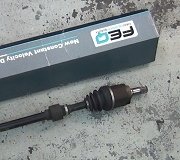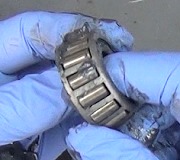Scratches and burrs do not scare me, but your comment about the bore not being perfectly round concerns me. I have a suspicion you are exaggerating the problem, at least I hope so. To create a sealing problem, you would have to crush the seal opening by trying to lift it there with a floor jack.
The housings are aluminum, so small burrs are going to become flattened when you pound the seals in. You do not want big burrs that can break off and get trapped inside. The way I would handle this is to jack the car up higher on the side you are working on now so no transmission fluid will dribble out. Spray the inside of the housing with Brake Parts Cleaner to wash off any trace of transmission fluid, then, with your finger, run a thin layer of RTV gasket sealer around it where the seal's metal ring will sit. That will take care of the scratches.
You will notice the new seal already has a coating on the outside. That will handle really light scratches in the housing, and it helps hold the seal in place. What you need to avoid with the gasket sealer in the housing is the "more is better" attitude. With a bead that is too large, as you push the seal in, that sealant is going to build up in front of it, and if that gets high enough, it could get onto the rubber lip seal. That can do away with the lip's effectiveness and let transmission fluid wick past it. You have to really pile the sealant on to cause that problem. You will not do that when using your finger to spread it.
If you do not already have a gasket sealer you like, the Chrysler parts department has two that I am real familiar with. I am sure other manufacturers have the same products with their own names on them, but since I know these, ... The black stuff stays a little more rubbery and is a little easier to scrape off next time, but it absolutely will not bond and seal if there is any hint of oil or transmission fluid on either surface. That is why I mentioned using the Brake Parts Cleaner. To address this on their older 4-speed automatic transmission pans, they came out with the gray sealant. That will seal through a light film of oil, but it cures a little harder, and it takes more elbow grease to clean it off next time.
With either of these two sealants, you do not have to wait for them to cure. You can pour the new transmission fluid or engine oil in right away.
Wednesday, October 31st, 2018 AT 7:05 PM



